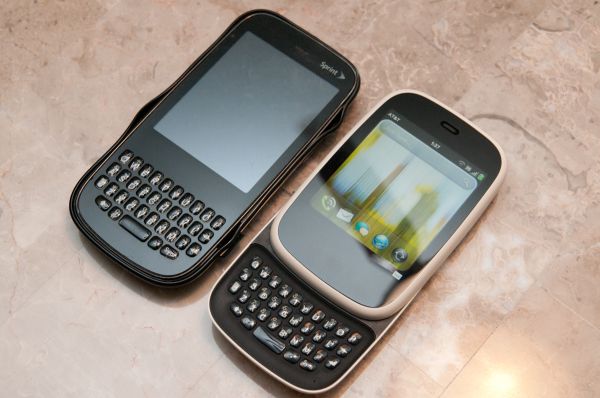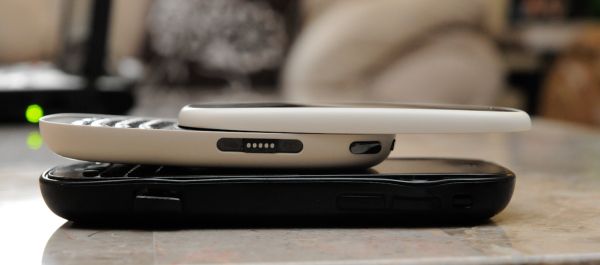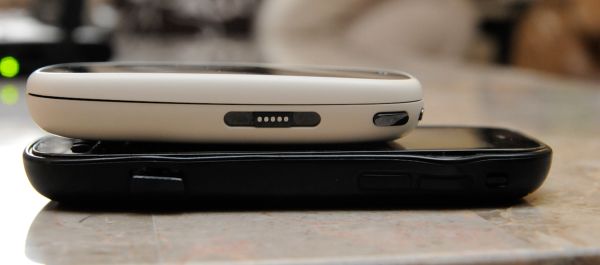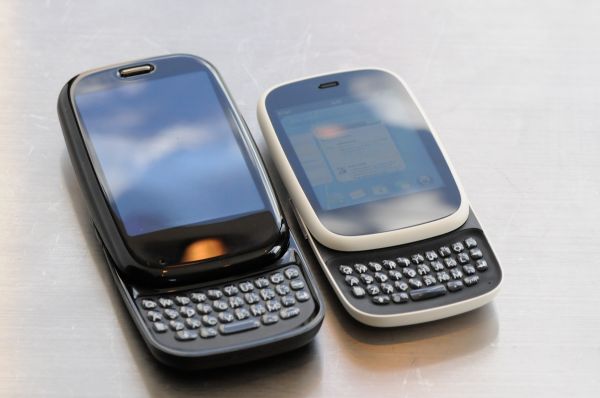HP Veer 4G Review - Getting Us Excited for Pre 3
by Brian Klug on June 7, 2011 5:01 PM EST- Posted in
- Smartphones
- HP
- AT&T
- Palm
- veer
- webOS
- HSPA+
- Mobile
- HP Veer 4G
We touched on the Veer when it first hit our doorstep with a this just in post, and since then I’ve been using the device daily and trying to get an understanding for where it fits in both HP’s vision for WebOS and the greater scheme of things among all smartphones. The Veer’s launch is quite honestly a puzzling one. Usually launches are top down - launch the big flagship first, then reduced size and price ‘lite’ editions afterward that build off the flagship’s success and appeal to niches that aren’t served by the primary device either due to cost or size. For that reason, the Veer launch initially seemed a bit backwards, but factor in HP’s desire to get excitement for WebOS 2.0 started and ignite interest for the Pre 3, and things begin to make sense.
 Size Comparison: (Left to Right) HTC EVO 4G (Sprint), Palm Pre Plus (AT&T), HP Veer 4G (AT&T)
Size Comparison: (Left to Right) HTC EVO 4G (Sprint), Palm Pre Plus (AT&T), HP Veer 4G (AT&T)
The HP Veer 4G (henceforth just Veer) is the Palm Pixi’s obvious spiritual successor. It’s refreshed with a faster SoC, better camera (but without an LED flash), WiFi, WebOS 2.0, and repackaged in a different, smaller form factor. The two bear the same exact same screen size and resolution (2.6 inch, 320x400), and both include a keyboard in a diminutive package. One of the Palm Pre’s original differentiators was the inclusion of a keyboard, and thus far every WebOS device has likewise included one. For extremely small devices, hiding a keyboard somewhere isn’t exactly an easy task.
 Left: Palm Pixi, Right: HP Veer 4G
Left: Palm Pixi, Right: HP Veer 4G
The Pixi included one by sticking it beneath the display, resulting in a long and skinny phone that ended up having a funny aspect ratio. The Veer, however, keeps a much more Palm Pre - like form factor with sliding keyboard.
If the Palm Pre full size devices could be described as feeling like smooth river rocks in the hand, the Veer is more of a pebble. It truly feels like a scaled down Palm Pre. It’s small - no, that doesn’t even do it justice. It’s downright tiny.
The Veer has an outline just smaller than that of a credit card, and hides a four-row QWERTY keyboard away in the slider and only tacks on 4.25 mm of thickness and 10.5 grams in the process compared to the Pixi.
While the overwhelming trend right now is ever increasing display size, it’s obvious that HP recognizes an unfilled niche on the other side of the spectrum for something incredibly small. There’s definitely a market for devices with pocketable size that don’t “print” with tight fitting clothing. I’m told by my female friends that having a small device that fits those criteria is a big part of smartphone shopping. That said, the Veer is still thicker than a bunch of other phones, which is perhaps an even more important criteria for female shoppers.
Whether the Veer goes in the front pocket or is small enough to make it into the back pocket is ultimately a matter of clothing choice and personal preference. I will say that it’s refreshing to carry something around that doesn’t weigh my pants down, though at times it’s easy to forget there’s anything in there at all when checking to make sure you’ve got keys, wallet, and phone.



















25 Comments
View All Comments
ClockerXP - Saturday, June 11, 2011 - link
Dial ##3-836# to get to the menu where you can disable 3G. Works on my Pre+ on Verizon!ClockerXP - Saturday, June 11, 2011 - link
I mean ##3836# (no dash)dananski - Sunday, June 12, 2011 - link
I agree that the hardware is better than people say. I haven't had any problems with mine and it only has minor scratches from all the times I've dropped it. But the OS is good too. Cards and synergy are two things I couldn't go without, and I like the simple gestures.ioannis - Tuesday, June 7, 2011 - link
Brian, thanks for the comprehensive review, delivered in the usual Anandtech quality.The App Catalogue compatibility seems to be the only major complain I'd have over this phone. My question is, will WebOS 3.0 with the Enyo framework come to the Veer? And assuming that all the apps eventually get ported to it (or at least all apps released from the time 3.0 is out will be based on it), would that solve the 'pixel density'/resolution-dependent apps problem?
softdrinkviking - Tuesday, June 7, 2011 - link
Hi Brian. Great review. I especially liked your explanation of HSPA+, nice work there.I had one question. You again referred to Super LCD as (IPS) in this article, as you did in the article a few days ago (HTC evo 3D). In that article you crossed out the (IPS) and I assumed that meant you were reassessing that. Have you come to any conclusions about Super LCD and what process it is made with?
Brian Klug - Tuesday, June 7, 2011 - link
So I was mistaken earlier about Super LCD being IPS, I went over my notes and have written down that Super LCD is just PVA. I'm going to try and do some more digging to find out why I have that here and what the implications are. Honestly though the SLCD display on the Sensation looks quite good.-Brian
Solidstate89 - Tuesday, June 7, 2011 - link
I haven't owned a WebOS phone because of the flakiness of the hardware, but the OS has always appealed to me. Similarly although the Veer isn't for me, I do like just how much better WebOS 2.0 is looking.I sincerely wish them the best in the market as it is quite simply a brilliantly designed OS. However it's just taken too long to get to market. I wanted to get a Pre 3 on Verizon, but realized it would be too late with Verizon Wireless nixing its Unlimited Data plans before it could be released so I went to sprint and picked up a WP7 device.
Quite happy with it, and although it's a blatant rip-off, I can't wait for the card-style multitasking to arrive with the Mango Update :)
Best of luck to WebOS.
softdrinkviking - Tuesday, June 7, 2011 - link
cool, thanks for the reply & info. i have seen plenty of PVA screens in the store and they look pretty good to me, maybe not as good as the high-end NECs and other professional monitors, but i had a hard time telling the difference between the led backlit LG IPS and the similar sized BenQ with a PVA. (this is in Japan, so i can't say what models you have in the states).As long as they are good quality, and a decent resolution, I can't imagine that PVA would be unacceptable on a cel phone. they are undoubtedly better than TN.
jamawass - Wednesday, June 8, 2011 - link
I think the veer makes sense if you take into consideration hp's tablet strategy. A veer with mobile hotspot would be an excellent combo with a 7 in touchpad ( to be released after the 10 in later this yr). I have a 7 in sony reader which fits in all my jacket's pockets. That's my device of choice when I'm waiting at the auto shop, etc and I always receives glances when I whip it out of my jacket. It's light, and much more portable than an ipad.I suspect this is one of hp's strategies with the veer and I wouldn't be surprised if they market them as a combo deal in the future.
I've used webos for a year now and generally like it's efficiency, but Apple and other companies have been cannibalising their innovations. As stated above, hp needs to accelerate the upgrade cycle in both soft and hardware to survive.
marc1000 - Wednesday, June 8, 2011 - link
Brian and Anand, I could not find a way to contact you. So I will write this down on the comment section.Microsoft is killing the only thing cool on all older WindowsMobile phones (6.5 & below): the MyPhone service will die in a couple months.
please read this thread at XDA where some users reported receiving the same MS email with the news.
http://forum.xda-developers.com/showthread.php?t=1...